AMD Announces Carrizo and Carrizo-L, Next Gen APUs for H1 2015
by Ian Cutress on November 20, 2014 5:45 PM EST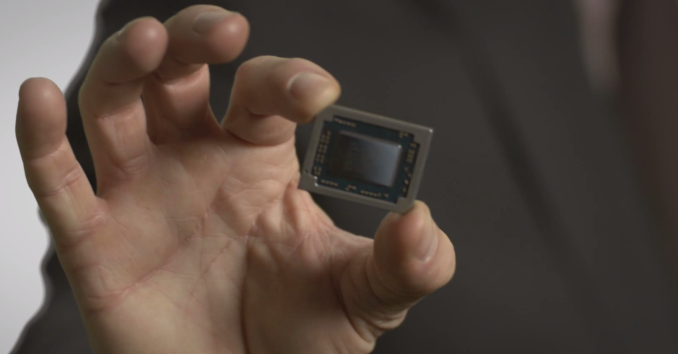
Today AMD is announcing the long anticipated upgrade to Kaveri, codenamed Carrizo. Carrizo is the natural successor to Kaveri, featuring x86 ‘Excavator’ cores alongside a Radeon-class GPU and promising an increase in performance all around. The second part of today’s announcement is for Carrizo-L, an SoC pairing “Puma+” (upgraded Beema) cores also with AMD’s R-series GCN GPUs and a FCH into a single package. Both Carrizo and Carrizo-L will feature ARM Trustzone, giving potential hardware-based built-in security when used by developers.
The Excavator cores are an architectural improvement over Steamroller, but are fundamentally based on the original Bulldozer concept. Excavator will be AMD’s fourth iteration of the concept, following Bulldozer, Piledriver and Steamroller. This new generation of APUs are still set to be built on the 28nm Super High Performance process at Global Foundries, delaying AMD’s shift to 20nm, but AMD are still claiming that the new GPU in Carrizo is their best yet, giving better performance and efficiency than before.
Given AMD's discrete GPU lineup, the GPU for Carrizo could be based on AMD's latest GCN 1.2 architecture, which was first introduced in the desktop Tonga part earlier this year. GCN 1.2's lossless delta color compression algorithms help improve the performance in memory bandwidth limited scenarios, such as in APUs. This could result in a bigger-than-expected jump in performance, although we will wait until we can test to find out how much it helps.
The Carrizo platform will be fully HSA 1.0 compliant, compared to Kaveri which only had ‘HSA Features’, as AMD puts it in their latest mobility roadmap update:
The push from AMD into HSA compliant APUs was well documented back at the launch of Kaveri earlier this year. This enabled the CPU and GPU components of the silicon, while under OpenCL 2.0 mode, to have access to the main block of system DRAM with zero-time copy functions, offering the potential for large classes of applications especially those in the prosumer and industry space to be accelerated by having instant access to the parallelization afforded by the GCN GPU. One of the big drawbacks of being an earlier adopter to HSA, as we noted at the time, was that software developers required time to bring their code to market, as well as AMD having to go out and teach the developers how to cater for HSA topology.
Both Carrizo and Carrizo-L on the mobile side will be targeted at the same power bands as Kaveri and Beema, although the socket will be new. The use of FP4 BGA also indicates that a single socket will cater for both the Excavator and Puma+ based APUs and would be interchangeable. A video by AMD’s VP/GM for Computing and Graphics, John Byrne, states that Carrizo and Carrizo-L are currently being tested internally ready for a 1H 2015 release, along with support for DirectX 12, OpenCL 2.0, Mantle and Freesync.
One of the big features that AMD is pushing with Carrizo is energy efficiency, with it being a keystone of the message. Because AMD have been on the same process node for a short while, they have to essentially follow the Maxwell example, by providing more performance for less power without the advantage of shrinking resistors. We were provided with an energy efficiency roadmap as well, showing the different methods AMD is using to achieve this:
One example of the efficiency improvement was provided by AMD’s Voltage Adaptive Operation. Rather than compensate for voltage variations which wastes energy, this technology takes the average operating voltage and detects when the voltage increases beyond a smaller margin. To compensate for this increase, the CPU speed is reduced until the voltage drops below the threshold and then the CPU speed is moved back up.
The changes in speed are designed to be so minute that it does not affect overall performance, however it might only take an errant voltage delivery component to consistently make the voltage go above that threshold, causing erratic slowdown that might be statistically significant. It will be interesting to see how AMD implements the latest version of this feature.
The 2015 desktop roadmap remains unpublished so far. AMD’s perception of a mobile-focused strategy would tend to suggest that the mobile comes first, with desktop following behind, although at this point it is unclear. A number of AMD’s marketing materials with this launch gave examples of the use of Carrizo and HSA for the prosumer, indicating that a desktop version should be announced in due course.
As of yet there was no discussion on the APUs to be launched, the speeds or the capabilities. All the roadmap tells us is 'up to four cores' (Excavator for Carrizo, Puma+ for Carrizo-L), some GCN compute units and 10-45W overall. There is no mention of DDR4 support, although the timeframe might be relevant for AMD to make the jump. Given the launch is still at least two quarters away, I would expect better details in due course. That timeframe fits in nicely around or just after Computex, perhaps indicating more details then.
Source: AMD


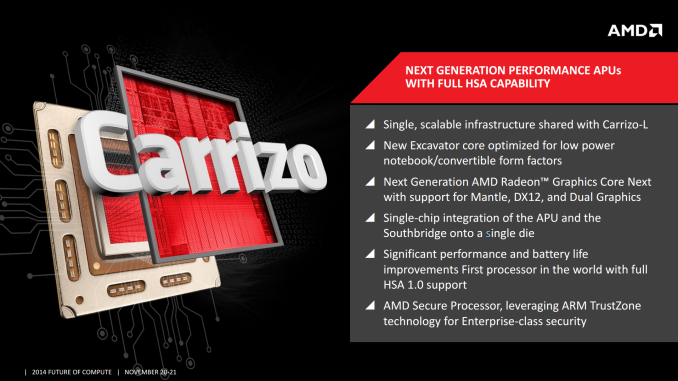
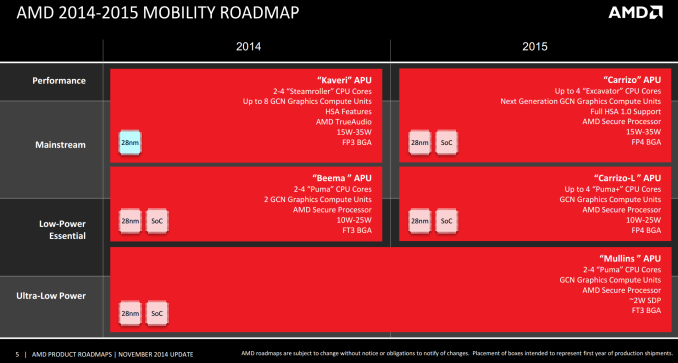
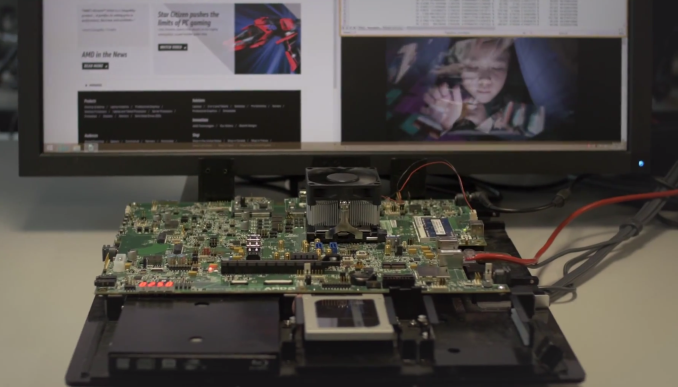
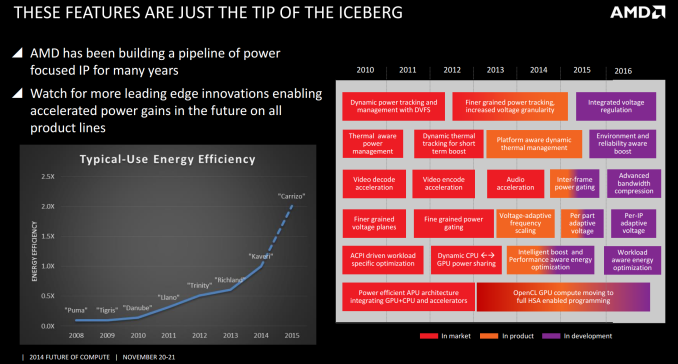
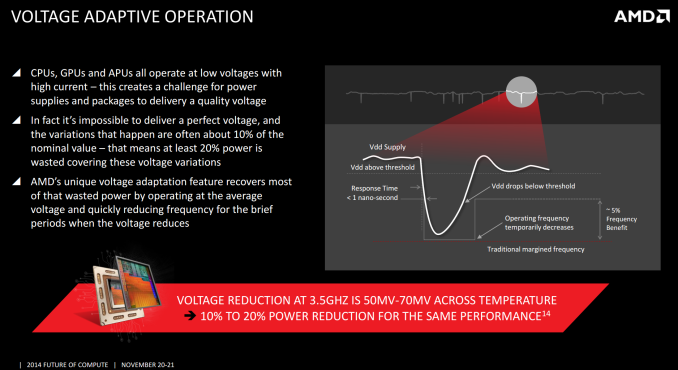
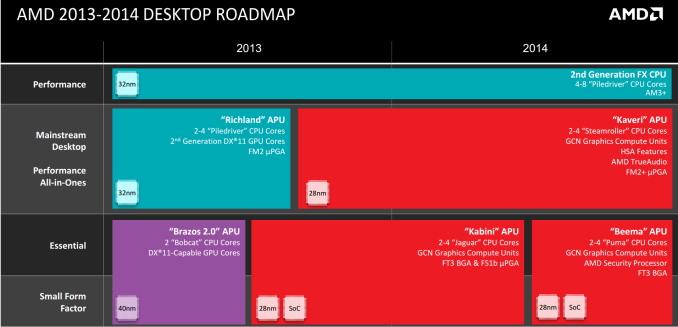








94 Comments
View All Comments
haukionkannel - Saturday, November 22, 2014 - link
Intel has money to develop several parallel CPU units... AMD can not. That is why they could not abandon bulldozer architecture, when they finally find out that programmers are not going to use parallel programming in big way...Intel has multiple times money and resources. It is hard to compete against. Lets hope that other manufacturers can actually get closer to Intel in production technology so that AMD can also benefit from smaller production node and reduced TDP...
Morg72 - Saturday, November 22, 2014 - link
What would be interesting is something along the lines of an APU with upgradeable GDDR5 for the GPU side and DDR4 for the CPU side. It would separate the memory bandwidth and offering upgrade ability for GPU memory would be unprecedented. Of course this would require motherboard and GDDR manufacturers to help design, support and supply the slot and chips. Would be great to be able to increase the GDDR from 1gb to 2gb as needed, instead of having to replace the whole unit.As for the "2nd gen FX CPU's" on the market so long, it makes a lot of sense for them. If they are abandoning the architecture next year, there was no real point in ramping up production of the newer chips that wouldn't really sell that well. Continue the current line until the actual new one is ready and put the production costs toward research for the new arch.
AMD has a CPU branding issue as well. Many of my clients hear "AMD CPU" and think they are a Intel knock off. The only thing they really get credit for is their GPU's. Intel made themselves a household name that implied premium quality. If the new CPU's can compete with Intel again, they need some serious marketing. But they really, really need to stop over-promising! The hype ahead of bulldozers release really doomed it. There was essentially no way for those chips to fill the expectations. When they didn't knock peoples socks off, we get what we have now, a lot of doubt and mistrust for AMD CPU's.
andrewaggb - Saturday, November 22, 2014 - link
I'm dissappointed there is no excavator + 7850+ graphics + edram or gddr5 or quad ddr4 or anything type product. It would be unchallenged and certainly have a small market of enthusiasts and steam boxes and other things. Even if you didn't sell alot, I think it would get people excited about AMD again and it would play to the only strength they've got at the moment.Sure you can get an i5 + standalone graphics card but it's not exactly the same thing.
piroroadkill - Sunday, November 23, 2014 - link
Yeah, AMD pretty much needs to sell the PS4 APU, but get rid of the garbage Jaguar cores and throw in a few of their latest and fastest x86 cores.J0nDaFr3aK - Sunday, November 23, 2014 - link
Is Carrizo going to use the FM2+ socket? Are there going to be new chipsets?lord_anselhelm - Monday, November 24, 2014 - link
I've yet to even see a Kaveri chip powering any available UK laptops :(Hope AMD can actually secure some design wins when these chips hard launch.
joseph97svk - Tuesday, November 25, 2014 - link
I think that with HSA, they can just cut out the FPU modules and let the GPU do all FP calculations. It cuts a lot of transistors in the core, decreases presure on core front end and opens it up for more integer calculations. If we take this and high density libraries, a sharp decline in power consumption and increased in performance is not a far fetched reality.estarkey7 - Tuesday, November 25, 2014 - link
Where is the True Audio Processor? I see they omitted it in the slides, did they dump it?Cryio - Tuesday, November 25, 2014 - link
The most dissapointing thing on Kaveri for me was that the iGPU was supposed to be as fast as a 7750 on desktop and it is actuallly slightly slower than a 7730 GDRR5.Dug - Tuesday, November 25, 2014 - link
The biggest issue besides performance, is the utter lack of marketing.They just don't get it. They could take a platform and market it for what it can do per dollar.
Could you imagine if they could get a full platform together to be the same as or better than xbox one or ps4, but run Windows?
Instead we have miscalculated release dates, unknown naming convention, and no way to promote their product.
99% of people don't care about nm or memory support, they want to know what the system can do, and they wan't to know the total cost.